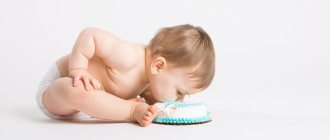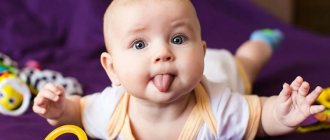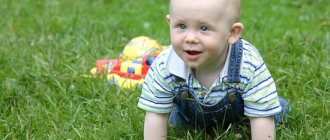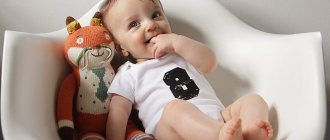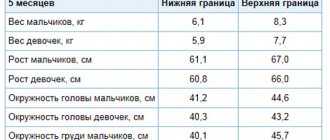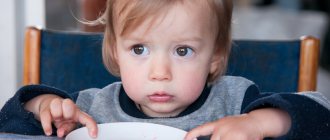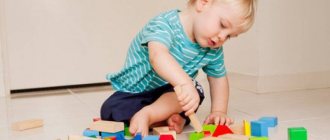It’s so nice to see when your baby is on par with his peers in his development, and maybe even ahead of them. This is a reason for parents to be happy and proud of their beloved child! In order to be sure that at the age of 10 months everything is going according to plan and there is nothing to worry about, the baby’s mother and father are required to conduct independent observations, which should be as objective as possible, in conditions that are comfortable for the baby.
Physiology of the baby
The child has matured, become very active, and already spends much more energy. And as a result, little weight gain. Over the past month, a baby can gain only 300 grams and grow only a centimeter. On average, a ten-month-old baby weighs from 8 to 10.5 kg and has a height of 71 to 75 cm.
My son weighed 10 kg 400 grams, and his height was 76.5 cm.
What changes in physiological development can already be observed in a child:
- He listens to what his parents are saying and tries to repeat the words he heard.
- Laughs when people coo and joke with him.
- He is happy when they start playing with him.
- Loves to play with a pyramid of multi-colored rings.
- Often plays with small objects. This develops the child's fine motor skills, but at the same time there is a risk that the baby will put something in his mouth, so do not leave him unattended.
- Loves to throw things and watch them fall.
- He can sit up on his own, crawls easily, and tries to walk while holding onto his mother or crib.
- Already able to chew, but only crushed food.
- Shows interest in other kids.
- Trying to take the first steps.
- Holds a cup and spoon independently.
- Able to get in and out of bed.
- Can hold two objects with one hand at the same time.
- It is very important for him to hear praise from adults, especially from his mother.
- Shows fear of strangers and panics when left in an unfamiliar place.
- Fulfills small requests from parents.
Weight and height standards
Girls are smaller in height and weight than boys. The difference in body weight by 10 months of age is 0.7-1 kg, and in height - 2-3 cm. The norms of parameters are given in the table below.
| Gender of the child | Height, cm | Head circumference, cm | Body weight, kg | Chest circumference, cm | Size of large fontanel, mm |
| Girls | 69-74 | 45-46 | 8,2-10,8 | 43-44 | 12-14 |
| Boys | 71-76 | 46-47 | 9,2-11,5 | 44-45 | 12-14 |
Ten-month-old girls already have several teeth. First, two front incisors appear, and then a pair of lateral incisors. The given standards are not strict. Minor discrepancies should not be a cause for concern.
It should be taken into account that the following factors influence the development of a child:
- diet;
- health status;
- genetics;
- degree of activity;
- Conducting developmental activities by parents.
If the actual indicators of physical development differ greatly from the standard, then you need to contact a pediatrician.
Motor activity of a toddler
At ten months, the baby already has the following skills:
- He takes small objects with his thumb and forefinger, makes pyramids, presses small buttons.
- Throws things out of closets and cribs.
- Sits independently. Can sit down, both from a standing and lying position.
- Crawling confidently. Don't be discouraged if your baby doesn't do this. My friend’s son didn’t crawl at all, and at 11 months he immediately stood up and walked.
- Can climb in and out of low beds.
- She can get up or even walk slowly, while holding on to her mother’s skirt or some piece of furniture.
- Perhaps your baby can already move around holding onto a support with only one hand, especially if the other is occupied with a toy.
What to do if your baby has slow development of fine and gross motor skills?
All children are individual, and their development occurs differently. That is why all the ages and stages given above should be taken as approximate: your baby may master some skill earlier than the average child or, conversely, be delayed a little.
Continue to practice fine and gross motor activities and games with your baby. Do not scold him or use him as an example for other children. If it seems to you that development is not going as it should, consult a doctor - only a specialist can make a verdict in such a situation. We believe that your baby will definitely succeed!
Development of psychological skills
- The baby listens to you carefully and understands what you are talking about.
- Tries to repeat heard sounds.
- Can point to objects that are being talked about or that he wants to be given.
- Laughs if he hears a funny story.
- The child tries to be like his parents in everything.
We bought our son a toy phone and dishes. He was happy that he could act like an adult too.
- The baby already regularly waves goodbye to you.
- He is happy when he is praised and is offended when he is scolded or not allowed to do something.
- Throws toys and other things all over the room.
- He is interested in his body and compares himself with other children. The baby may want to touch the neighbor’s child’s nose or ear.
- Long-term memory is already working well. The baby remembers where you put something and will easily find it in a day.
What types of exercises are there to develop gross motor skills?
Both fine and gross motor skills of a child are, first of all, skills that are important in adulthood. Try to show your child by example that you like to move, walk, do household chores, and that lying around for hours on the phone or sitting in front of the TV for half a day is not at all interesting (even if this is not at all true). If you can instill in your child a love of an active lifestyle, you will give him a huge incentive to independently develop gross motor skills. And here are a few more recommendations to speed up this process.
Tip #1: Dance
From what age: with the support of the mother - at least from 6 months, independently - when the baby learns to walk confidently.
The best results are achieved when gross motor skills activities become fun for children. This is why dancing is a great choice, because who doesn’t love to dance!
Encourage your child to move to the music from his favorite cartoons, repeating the dances of the characters. Dance with him in pairs or watch the baby's solo performance, be sure to accompany him with approving applause. As your child grows up, show him videos of your favorite performers so that he can gradually move on from simple dances like “two stomps, three slams” to more serious techniques for developing gross motor skills.
Tip #2: Play sports
From what age: from about one and a half to two years.
If your baby is confident on his feet, offer him sports games to develop gross motor skills. This is not a real sport, but simply an exercise based on motives, but it will bring considerable benefits. Buy your child a ball of a suitable size and play “football” with it - lightly pass to each other, kick it into a doorway or other improvised goal. Then move on to “basketball”, finding some suitable bucket or pan at home.
Tip #3: Do exercises
From what age: individual exercises - from 1 year, traditional exercises - from 4-5 years.
When we do home exercises together, we not only develop gross motor skills in our children, we also teach them a healthy lifestyle and help them stay physically fit. In general, a thing that is useful in all respects.
Already at the age of one year, you can invite your baby to do exercises with you. Of course, his movements will be clumsy, and all this will bear little resemblance to real gymnastics, but now the task is suddenly to instill a love of exercise. If you can, by the age of 4–5 your child will do them no worse than you, maybe even better.
Tip #4: Ride a bike
From what age: from 1 year.
The baby can be put on the first bicycle (three-wheeled and with a safety handle on the back) at a very early age. By controlling it, the child trains the leg muscles, sharpens the movements of the arms and learns to synchronize the actions of all four limbs. This is one of the best options for developing gross motor skills.
As your baby gets older, switch to more advanced models to practice coordination, balance and other important skills. By the way, don’t limit yourself to just a bicycle: all wheeled vehicles are useful - a scooter, a skateboard, a unicycle, and a hoverboard.
Tip No. 5. Do not limit your baby’s physical activity without reason.
From what age: always.
“Why do you need to develop motor skills, it’s better to just sit and do nothing,” a mother or father is unlikely to say such a phrase to their baby. However, many parents pronounce it in a veiled manner, because all “don’t get in there,” “don’t jump from there,” “don’t go far,” “don’t run,” “play here” are just its variants.
Often, parents turn on the “super-protection” mode and limit the baby’s activity only because they do not want to be distracted from their work or are too lazy to soberly analyze the situation. Did your child want to climb the slide? Put your phone down, get off the bench, and back him up. Decided to walk along a high curb? Take your hand, don't forbid.
Do not try to protect your baby from the slightest danger. Remember: mastering gross motor skills means learning to confidently perform actions that can be dangerous for an untrained child.
Emotional and social abilities
In this development, the baby also undergoes changes. Here's what you can already observe:
- The child learned to convey his feelings through babbling, rather than tears and screams.
- I began to understand the words of prohibitions. And maybe out of spite the mother does bad things, the baby even enjoys being scolded. Although some children still get offended and upset.
- He makes funny sounds and laughs at them himself.
- He gets upset to the point of tears if they start taking away his favorite toy or force him to do something he doesn’t want.
- He already knows how to ask to go to the toilet (to use the potty).
- He loves when he is given the right to choose.
My son, for example, really loved it when I allowed him to choose the book that we would read.
- Loves to play, both with himself and with other kids.
Rules for caring for a 10 month old baby
In addition to developing skills, it is important for the baby to strengthen his immunity, and mom and dad can help with this.
Children at this age already prefer the floor to the sofa, on which they can move any distance. To avoid skin problems, bathe your baby twice a day - rinse lightly, that's enough. Hardening is carried out using the method of wet rubbing, but do not turn rubbing into torture. If your beloved child is nervous and reacts poorly to such manipulations, put the idea aside.
We are developing correctly
Let's help our children in their development:
- It will be useful to carry the child in your arms, not for long, no more than an hour a day. The baby should feel the touch of your body, your love, care.
- You shouldn't babysit with your child. Talk to him like an adult, like an equal. This will help to avoid future speech defects in the baby.
- Take care of your little one's sense of humor.
- Create a large space for your child to move, and most importantly, a safe one.
- Point to parts of your child’s body and say what they are called, and then ask the baby: “Where is your nose?”
- Don't scold your child for throwing things around. Find a target where you can throw everything. Show your little one how to do this.
- Develop your child's creative abilities. At this age, you can slowly teach your little one to draw or sculpt from plasticine.
- Give your child no more than three toys at a time, change them every day.
- Be sure to read fairy tales and poems, especially before bed.
- Massage your baby every day. Don't forget about gymnastics.
Fine motor skills - what is it?
This term refers to precise movements of the wrist, hand and fingers, as well as the feet and toes. In other words, this delicate and coordinated work of muscles, bones and nervous system. The development of fine motor skills begins in children from a very early age and goes through the following stages.
From birth to 2 months
Fine motor skills of the hands in children in the first two months of life are subject to innate reflexes. They make involuntary movements with their fingers - sometimes for no apparent reason, and sometimes in response to external stimuli. For example, if you press your fingers on the palms of a newborn, he will clasp them. This skill is called the “grasping reflex” and was inherited from our ancestors - with its help, tiny baby monkeys are held on their mother’s fur.
From 2 to 6 months
At this age, the child develops primary coordination of movements - he begins to use vision to control the actions of his hands. Conscious fine motor skills appear, and for children of such a young age this is a great achievement. The baby learns to grab objects that fall into his field of vision, but until he knows how to sit, he reaches for them with both hands.
From 6 to 12 months
Improving vision, hand muscle strength and, most importantly, the ability to sit and not fall give a significant breakthrough in the development of fine motor skills of the hands. In the second six months of life, the baby learns to transfer objects from one hand to another, first mastering the tweezer grip (thumb, index and middle fingers), then the pinch grip (thumb and index finger only). If the child cannot reach something, he stretches out the handle and points his index finger at the desired object.
From one year to two
The child moves to the next level - he doesn’t just grab objects, he studies them. The baby begins to understand the differences in shape and size, realizes that some of them are heavy and others are light, and learns to measure the effort applied. At this stage, developmental activities are very useful for babies and can significantly improve fine motor skills. With a high probability, it will now become clear whether he is right-handed or left-handed.
From two to five years
At an early age, the child mastered static grip, i.e. the ability to grasp and hold an object without moving your fingers. Now he develops a dynamic grip - the ability to operate an object in a complex way, for example, cutting paper with scissors, drawing with a brush, writing with a pen. Between the ages of 3 and 5, girls often outperform boys in developing fine motor skills, so if your son seems clumsy compared to the neighbor's daughter, that's normal.
Features of girls and boys
At the age of ten months, you can already find differences in the behavior and development of children of different sexes.
What should a 10 month old boy be able to do?
- He takes things out of cabinets and shelves and throws everything away.
- Easily climbs onto chairs and even onto tables.
- Starts talking later than girls. He is not interested in copying what adults say.
- Very active and loves to get into trouble.
- It takes a lot of effort to force your son to do something.
- He wants to do everything himself, without the help of his mother.
Organization of employment and leisure for a ten-month-old baby
Daily baby care
The already familiar procedures in the daily routine remain the same. Washing, combing, brushing teeth (even if there is only one tooth), bathing in the evening. From time to time you need to carefully trim your nails.
It is advisable to harden with the help of sun and air baths, including rubbing. From this age it is already allowed to pour water on the feet, gradually lowering its temperature. Many pediatricians consider the best form of hardening to be pouring warm water from head to toe (gradually lowering its temperature). Do not forget that all hardening procedures must be systematic and gradual. And wakefulness is rich in both active and intellectual games, more fresh air and a complete rejection of TV and other screen gadgets.
Daily regime
Parents should continue to maintain a daily routine, smoothly adjusting it to the needs of the growing child. So, the baby continues to sleep 14-15 hours a day, going to bed twice during the day - 1.5 - 2 hours each. Morning rise time is from 6 to 8, depending on the habits of a particular family and the child’s temperament. Part of the daytime sleep, like that of a baby, takes place in the fresh air, during the first time outside.
You should also walk with your baby twice a day and eat 5 times. The intervals between meals are still 4 hours. Children at 10 months continue to receive breastfeeding or formula 1-2 times a day. The main diet consists of porridge (buckwheat, corn, rolled oats, rice, millet), some vegetables and fruits, meat (beef, chicken breast, turkey). At 10 months, fish is added to the menu. The food is ground into pulp.
The gymnastics that the baby does becomes slightly more complicated, depending on the program that the parents have chosen. In general, the child’s regime differs little from the one to which he was previously accustomed.

